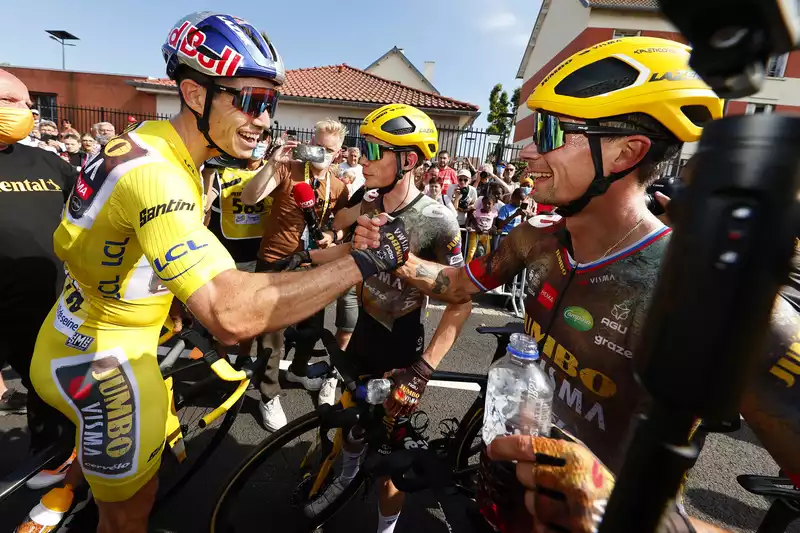Team Jumbo-Visma confirmed Tuesday that it will avoid using Shimano tubular wheels, which were used under Christophe Laporte and Wout Van Aert in Paris-Roubaix this spring.
Instead, the team will switch to new Shimano Dura-Ace wheels, while simultaneously switching from tubular to tubeless.
Equipment choice may be the key to the team's success as stage 5 of this year's Tour de France traverses 19.4 km of cobblestones in Roubaix. On a day that will not be won or lost, but could certainly be lost, avoiding significant time loss is the main goal of the GC favorites, which include Primoš Roglic and Jonas Vingegaard.
Monday will be a "free rest day" in Northern France after the long trip from Denmark.
"We decided to return to the cobbles, where the riders have already experienced this stage twice this winter and in March, because we wanted to have a fairly intense session and above all test the bikes again," Jumbo Visma performance director Mathieu Heyboer told L' Equipe.
Heijboer also revealed that the team would be switching from the Cervélo S5 aero bike to the more comfotable Cervélo Caledonia.
"Everyone will be using Paris-Roubaix-specific bikes. The frame absorbs the vibrations of the cobblestones and even if we only have 20 kilometers to ride, they are the most important kilometers of this stage. It's certainly not the best bike for bunch sprints, but it will reduce the fatigue of the riders considerably"
.
The main advantage of tubular wheels and tires is that they allow you to keep going even if you get a flat tire. Of course, rolling resistance increases and cornering traction decreases, but because the tire is glued to the rim, it will not come off by itself.
Therefore, it is deemed safer to keep driving until a team car gets close enough for a quick wheel change than to leave the rider stranded on the side of the road waiting.
Two accidents in Paris-Roubaix occurred after Laporte and Van Aert tried to take advantage of this fact and continue riding over the cobblestones. However, because the flat tires had no cushioning, each cobblestone hit the carbon fiber rim. Eventually, the rim cracked and the wheel bent.
Perhaps due to a lack of stock, Jumbo Visma used Shimano's R9100 Dura-Ace wheels. The team now has access to new wheels, so the change was made to prevent the same mistake from happening to the GC leaders.
"This time, unlike Paris-Roubaix (where Van Aert and Laporte had punctures), we will use tubeless instead of tubulars. In Paris-Roubaix, they were still using last year's model."
However, the switch to tubeless is more of a tactic than logistics, as the team has also acquired new tubular Dura-Ace wheels.
Tubeless tire technology, widely adopted in mountain biking, is relatively new in the pro peloton. Its main advantage is the ability to self-seal punctures, allowing riders to continue riding as if nothing had happened. If it works, it is arguably the best solution currently available for pro riders, but it does not always work.
A completely punctured tubeless tire is likely to come off the rim and force a complete stop. Recent advances in technology have somewhat eliminated this problem, allowing tires to stay in place even without air, but they are still not as secure as tubulars held together with glue. Riding on cobblestones carries the same risk of fatal failure as a punctured tubeless wheel.
However, after the Paris-Roubaix accident, Jumbo Visma seems to trust tubeless enough to use them on such an important day. At the very least, he believes that the benefits of a self-sealing tire outweigh the increased risk of the tire coming off the rim and forcing a complete stop. Given that tubular wheels have failed and forced complete stops, one can understand why.
"Our leaders, Primos Roglic and Jonas Vingegaard, have been training on these bikes since May. They took part in the GP Dunant on this bike (there were 12 cobblestone sections for a total of 20 km) and had several sessions on the training course on roads that were not always paved. Of course, these are all little things that add up, but it is the little things that give riders confidence."
Heyboer also confirmed that the main goal for Van Aert, a specialist in the classics, at this stage was to play the role of domestique.
"Of course, we have prepared a lot for this stage and although it may seem unsuitable for a rider like Wout Van Aert (2nd in the last Paris-Roubaix), he will help Primoz and Jonas to finish tomorrow in the best position. Even if he gets a yellow, it should not detract from our goal.
.

Comments